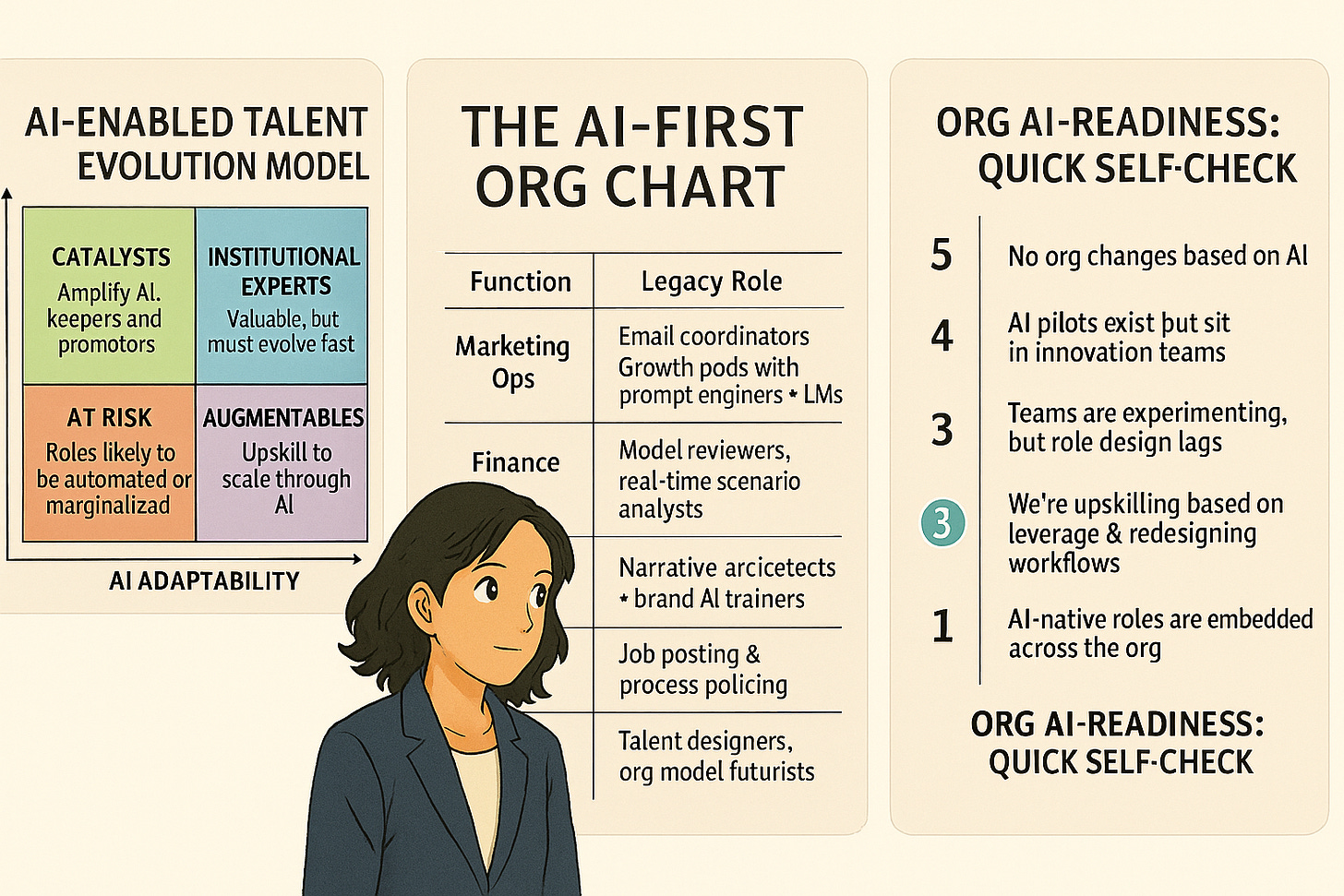The AI-First Org Chart: What Changes, What Stays, and What Gets Replaced
How to redesign your operating model for speed, scale, and survivability in the age of AI
AI is no longer a tool you add to the edge of your business.
It’s a force reshaping the center—from workflows to headcount, decision rights to team design.
So here’s the question:
If AI is changing how value is created… is your org structure still creating value the right way?
In this post, I go beyond job loss headlines to explore the AI-first organization—what changes, what stays, and what quietly gets replaced.
We’ll break down a practical framework, offer a team-wide diagnostic, and help boards and leaders take action—before the structure starts working against them.
Why This Belongs in the Boardroom
Org charts are not static.
They are operating systems. And AI is now rewriting the core logic.
Executives and board members must now ask:
Do we know which roles are AI-amplified vs AI-exposed?
Are we hiring and promoting based on judgment + adaptability—not just tenure?
Who is accountable for designing the AI-first org, and what does that design even look like?
If your org chart hasn’t changed since before ChatGPT,
you’re leading from behind.
The AI-Enabled Talent Evolution Model
Here’s the 2x2 every leadership team should be using.
Axes:
X = AI Adaptability
Y = Human Leverage in the Age of AI
Org charts aren’t just lines.
They’re leverage maps. And this is how you read them in 2024.
Catalysts
Creative, cross-functional, systems thinkers
✅ Invest deeply. Assign AI pilots. Build succession plans around them.
Examples: Product leaders, growth PMs, customer journey architects, brand strategy + AI.
Institutional Experts
Trusted advisors with domain depth—but limited AI fluency
🛠 Pair with AI-fluent teams. Upskill. Rely on judgment, not production.
Examples: Controllers, comms execs, planning leads, senior compliance officers.
Augmentables
Process-heavy, repeatable—but adaptable
📈 Train in prompting, workflow redesign, copilots, and automation tools.
Examples: Coordinators, analysts, social content creators, junior ops staff.
At Risk
Low creativity + low adaptability = automate or exit
⚠️ These roles disappear first. Reskill or replace with scalable systems.
Examples: Basic admin, reporting-only analysts, rule-based procurement, junior schedulers.
EXECUTIVE EXERCISE: THE AI TALENT HEATMAP
Use this in your next leadership offsite.
Step 1: List 20 high-visibility roles (not titles—roles).
Step 2: Plot them in the 2x2 above.
Step 3: Color-code for action:
✅ Green = Invest / Promote (Catalysts)
📘 Blue = Retain + Reskill (Experts)
🟣 Purple = Upskill Fast (Augmentables)
🔴 Red = Phase Out / Redesign (At Risk)
Now ask:
Which quadrant is overrepresented in our org today?
What’s the cost of that in six months?
What Changes in the Org Chart
Let’s get specific.
AI doesn’t just remove tasks. It reshapes the job itself.
What Stays (And Becomes More Valuable)
Strategic judgment
Creative intuition
Empathy and trust-building
Vision-setting
Values, culture, and tone
These aren’t eliminated. They’re amplified—when paired with systems that scale.
What Gets Replaced
One-dimensional roles
Redundant summaries (layered approvals, meeting rehashes)
Low-context decision gates
Manual formatting, templated writing, data wrangling
If someone’s job is 80% formatting and 20% thinking—it’s already a prompt away from being obsolete.
💡 Why This Drives Value
📉 Cost Optimization
Replace manual layers with scalable copilots
⏱ Speed to Insight
Real-time simulations, not backward-looking reports
🧠 Talent Clarity
Invest in roles that create multiplier effects, not maintenance
📊 Board Visibility
Elevate the talent conversation from attrition to adaptation
ORG AI-READINESS: QUICK SELF-CHECK
Score your org on a scale of 1–5:
1️⃣ No org changes based on AI
2️⃣ AI pilots exist but sit in innovation teams
3️⃣ Teams are experimenting, but role design lags
4️⃣ We're upskilling based on leverage & redesigning workflows
5️⃣ AI-native roles are embedded across the org, supported by new metrics and operating logic
Most orgs are between 2 and 3.
The leaders? They're already at 4.5 and recruiting for 5.
💬 Board-Level Reflection
If your org chart reflects a structure designed for a pre-AI world,
how long can you expect it to drive post-AI outcomes?
What’s the redesign you know you need—but haven’t resourced yet?
📩 Coming next:
“The Talent Stack of the Future: Skills, Mindsets, and Roles for the AI-First Enterprise”
This isn’t about eliminating jobs.
It’s about eliminating irrelevance.
The future org isn’t smaller.
It’s sharper, faster, and strategically augmented.
👉 Subscribe here to follow the full series.
👇 Comment or DM: What role or team are you rethinking in this next wave?
— Ekta
Human. With AI Superpowers.






Hi Ekta, This is impressive. I like how to you took a traditional org chart and added AI as a capability and refreshed it to be more relevant and future forward. I was wondering where/ how you would place roles like ecommerce manager or site merchandiser? For most DTC brands, these roles are crucial for revenue generation and website management. Although AI is increasing playing an important role at an executionary level, how do you see these legacy roles play out in the AI adaptability scale?
Excellent breakdown between low and high-level and what gets phased out versus what gets amplified. Really enjoyed it and you laid it out really simply.